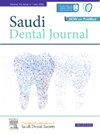Patterns of mandibular third molar impaction and its relationship with distal caries in the adjacent mandibular second molars: A retrospective study
IF 2.3
Q3 DENTISTRY, ORAL SURGERY & MEDICINE
引用次数: 0
Abstract
Background
Impacted third molars can cause significant challenges for dental health. While many of these impacted teeth remain asymptomatic, they can lead to dental caries.
Objective
To investigate the patterns of mandibular third molar impaction and its relationship with the occurrence of caries in the adjacent mandibular second molars.
Materials and Methods
This study assessed the dental panoramic radiographs of 1591 participants who visited the Department of Oral and Maxillofacial Surgery at the Dental Teaching Hospital at Umm Al-Qura University between 2022 and 2024. The presence of distal caries in the adjacent mandibular second molars was assessed and compared across the different impaction patterns, considering both age and gender.
Results
The results showed that 29.22 % of the patients had impacted mandibular third molars. The most common patterns of impacted mandibular third molar angulation were mesioangular in the females and horizontal in the males. The majority of these impacted third molars were level A and class I (as per the Pell and Gregory classification).
One hundred and eighty-three (39.35 %) of the impacted mandibular third molars had associated carious lesions, with 89 showing distal caries in the adjacent mandibular second molar and 18 showing caries in the third molar itself. The carious lesions were most commonly found in cases of mesioangular, level A, and class I impaction patterns (p < 0.05).
Conclusion
The findings of this study shed light to the high prevalence of carious lesions associated with impacted mandibular third molar, especially in cases of mesioangular, level A, and class I impaction patterns. These findings highlight the importance of careful monitoring of impacted third molars to prevent the development of caries in the adjacent teeth.
下颌第三磨牙嵌塞的类型及其与邻近下颌第二磨牙远端龋的关系:回顾性研究
第三磨牙的磨蚀会对牙齿健康造成重大挑战。虽然许多受影响的牙齿没有症状,但它们可能导致龋齿。目的探讨下颌第三磨牙嵌塞的形态及其与邻牙第二磨牙龋的关系。材料与方法本研究评估了2022年至2024年间在Umm Al-Qura大学牙科教学医院口腔颌面外科就诊的1591名参与者的牙齿全景x线片。在考虑年龄和性别的情况下,评估并比较邻近下颌第二磨牙远端龋齿的存在。结果29.22%的患者存在阻生下颌第三磨牙。下颌阻生第三磨牙最常见的成角模式为中角型,男性为水平型。大多数的第三磨牙是A级和I级(根据Pell和Gregory分类)。183例(39.35%)阻生下颌第三磨牙伴有龋齿病变,其中89例表现为下颌第二磨牙远端龋齿,18例表现为下颌第三磨牙本身龋齿。龋齿最常见于中角、A级和I级嵌塞(p <;0.05)。结论本研究结果揭示了下颌第三磨牙阻生的高发病率,特别是中角、A级和I级阻生的病例。这些发现强调了仔细监测阻生第三磨牙以防止相邻牙齿龋齿发展的重要性。
本文章由计算机程序翻译,如有差异,请以英文原文为准。
求助全文
约1分钟内获得全文
求助全文
来源期刊

Saudi Dental Journal
DENTISTRY, ORAL SURGERY & MEDICINE-
CiteScore
3.60
自引率
0.00%
发文量
86
审稿时长
22 weeks
期刊介绍:
Saudi Dental Journal is an English language, peer-reviewed scholarly publication in the area of dentistry. Saudi Dental Journal publishes original research and reviews on, but not limited to: • dental disease • clinical trials • dental equipment • new and experimental techniques • epidemiology and oral health • restorative dentistry • periodontology • endodontology • prosthodontics • paediatric dentistry • orthodontics and dental education Saudi Dental Journal is the official publication of the Saudi Dental Society and is published by King Saud University in collaboration with Elsevier and is edited by an international group of eminent researchers.
 求助内容:
求助内容: 应助结果提醒方式:
应助结果提醒方式:


